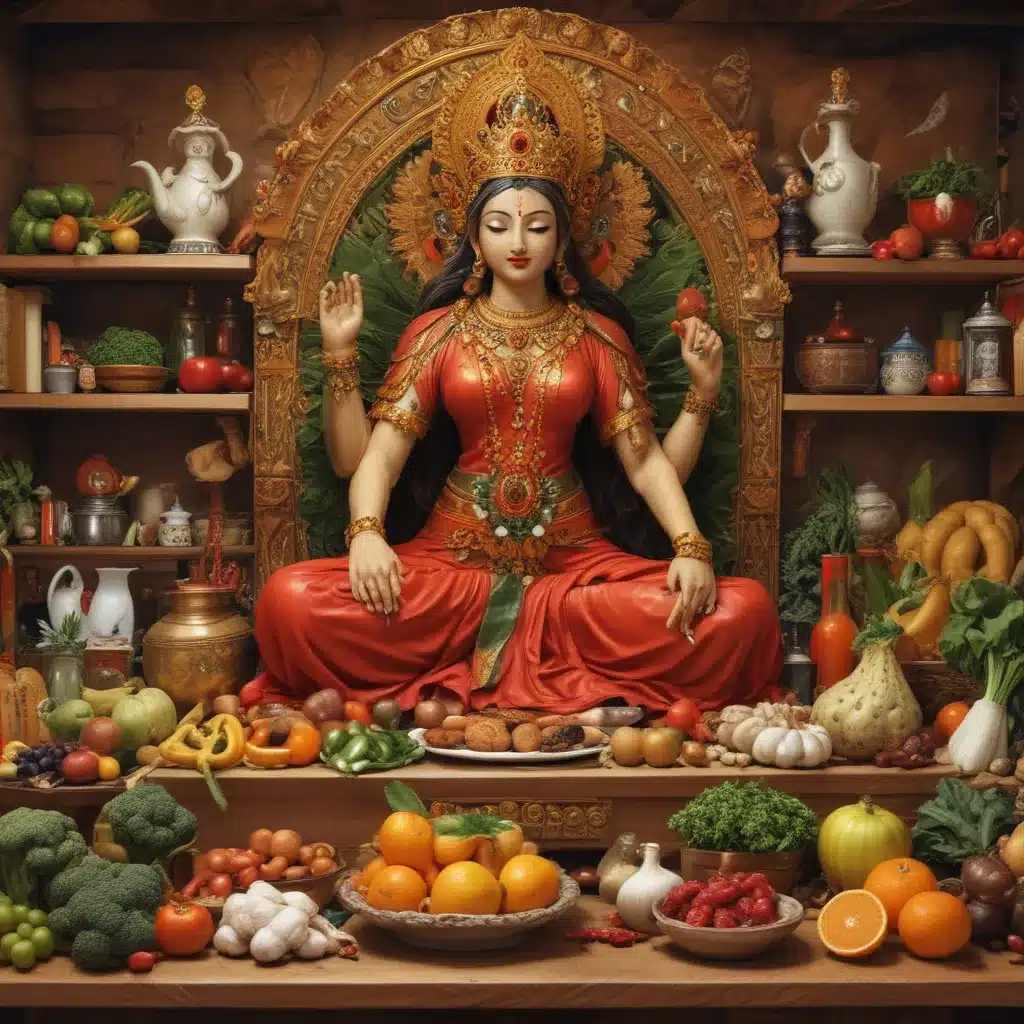The Mystical World of Culinary Rituals
Ah, the kitchen – that sacred domain where flavors are conjured, aromas are weaved, and meals become more than just sustenance. But did you know that in many cultures, the humble kitchen is also a realm of the divine? Let me take you on a journey through the intriguing world of kitchen deities and the sacred food customs that surround them.
As someone who has been immersed in the world of cleaning and maintaining pristine kitchens for years, I’ve always been fascinated by the deep-rooted connections between food, spirituality, and cultural traditions. It’s as if the pots and pans, the spice racks, and the cutting boards all hold a hidden, mystical significance that transcends the purely functional.
Let’s start our exploration by delving into the realm of kitchen deities. These are the revered, often anthropomorphized, figures that preside over the culinary arts and the sanctity of the home. One such deity is Annapurna, the Hindu goddess of nourishment and the giver of food. She is often depicted holding a ladle and a bowl, symbolizing her role in sustaining life through the preparation of sustenance.
The veneration of Annapurna is deeply woven into the fabric of Indian culture. Devotees may offer the first morsel of their meal to her, acknowledging her as the source of their sustenance. In some households, a small portion of every dish is set aside as an offering, a way of honoring the goddess and sharing the bounty with the divine. Interestingly, the word “Annapurna” itself is a compound of the Sanskrit words “anna,” meaning “food,” and “purna,” meaning “full” or “complete.” What a beautiful testament to the idea that nourishment is a sacred act of completion and wholeness.
But Annapurna is not the only kitchen deity to capture the imagination of cultures around the world. In ancient Greece, the goddess Hestia was revered as the guardian of the hearth and the sustainer of domestic life. Her presence was invoked during every meal, as the first offerings of food and drink were made in her honor. The Roman equivalent, Vesta, also held a similar role, with her eternal flame representing the very heart of the home.
Interestingly, the reverence for kitchen deities often extends beyond the realm of the divine and into the realm of the everyday. In many traditional societies, certain kitchen utensils or ingredients are imbued with a sense of sacredness, requiring special handling or preparation. For example, in some parts of India, the rolling pin, or “belan,” is considered a manifestation of the divine feminine and is treated with utmost respect.
I remember visiting a family in rural Rajasthan, where the matriarch would carefully clean and decorate the belan before each use, almost as if it were a ritual. She explained to me that the belan was not just a tool, but a representation of Shakti, the primordial feminine energy that sustains all of creation. By honoring the belan, she was honoring the very source of nourishment and life itself.
Similarly, in many cultures, certain ingredients or dishes hold deep symbolic significance, often tied to religious beliefs or seasonal cycles. Take, for instance, the tradition of making “mandazi” (a type of East African fried bread) during the holy month of Ramadan. These fragrant, fluffy treats are not just a delicious snack but a way of celebrating the spiritual journey and connecting with the divine.
Or consider the ancient Japanese custom of “omizuage,” where the first harvest of rice is offered to the kami (spirits) before being consumed. This act of reverence acknowledges the sacredness of the staple food that sustains the community, as well as the cyclical nature of life and the importance of showing gratitude to the natural world.
As I delve deeper into these fascinating culinary customs, I can’t help but wonder about the universal human need to imbue our relationship with food with a sense of the sacred. Perhaps it’s a way of honoring the magic that happens when we transform raw ingredients into nourishing sustenance. Or maybe it’s a means of fostering a deeper connection with the rhythms of nature and the cycles of life.
Whatever the reason, one thing is clear: the kitchen is no mere utilitarian space – it is a realm where the mundane and the mystical converge, where the act of cooking becomes a sacred ritual, and where the deities of the culinary world preside over the sustenance of our bodies and souls.
Honoring the Hearth: Rituals and Traditions
As I delve deeper into the world of kitchen deities and sacred food customs, I’m struck by the sheer diversity of beliefs and practices that exist across different cultures. Each tradition seems to have its own unique way of acknowledging the sacredness of the kitchen and the transformative power of food.
Take, for example, the ancient Greek concept of the “hestia,” or the sacred hearth. In the homes of ancient Greece, the hestia was considered the very heart of the household, a place where the divine and the mortal intersected. The hestia was the domain of Hestia, the goddess of the hearth, and was tended to with great reverence.
Every day, the first offering of food and drink would be made to Hestia, acknowledging her as the sustainer of domestic life. The fire of the hestia was never allowed to be extinguished, as it was believed to be a living embodiment of the goddess herself. When a family moved to a new home, they would carry a portion of the sacred fire from the old hestia to the new, ensuring the continuity of the divine presence.
This reverence for the hearth as a sacred space is not limited to ancient Greece. In many traditional societies, the kitchen fire or stove holds a similar significance, serving as a conduit between the physical and the metaphysical realms.
In the Andes Mountains of South America, for example, the “puku,” or traditional stone oven, is seen as a repository of ancestral knowledge and a link to the divine. When a new puku is built, it is often consecrated with offerings and rituals to ensure its proper functioning and to invite the blessings of the spiritual world.
The Maori people of New Zealand, on the other hand, have a deep reverence for the “ahi kā,” or the “burning fire” of the home. This fire is not just a practical means of cooking, but a symbol of the ongoing presence and vitality of the family. The ahi kā must be kept alive, both literally and figuratively, to maintain the connection between the living and the ancestors.
Even in modern, industrialized societies, we can find vestiges of this sacred connection to the kitchen hearth. In many traditional Italian households, for example, the “camino,” or fireplace, is still the center of the home, where family members gather to cook, socialize, and share stories.
The act of tending to the fire, stoking the flames, and using the heat to transform raw ingredients into nourishing meals becomes a ritual in itself – a way of honoring the enduring link between the physical and the spiritual, the earthly and the divine.
As I reflect on these traditions, I can’t help but wonder about the profound impact they must have on the way people experience and engage with their culinary practices. Imagine how different it must feel to prepare a meal not just as a practical task, but as a sacred act of devotion and reverence.
Perhaps it’s this deeper, more spiritual connection to the kitchen that imbues the act of cooking with a sense of purpose and meaning. By acknowledging the sacred nature of the hearth and the transformative power of food, we tap into something primal and enduring within the human experience.
Feasting with the Gods: Rituals and Offerings
As I delve deeper into the world of kitchen deities and sacred food customs, I’m struck by the incredible diversity of beliefs and practices that exist across cultures. One fascinating aspect of this rich tapestry of traditions is the role of ritual offerings and feasting in honoring the divine.
In many belief systems, the kitchen and the act of cooking are seen as a bridge between the mortal and the divine realms. By making offerings of food and drink to the deities associated with the culinary arts, devotees seek to invoke blessings, gain divine favor, and foster a deeper connection with the sacred.
Consider, for instance, the Hindu tradition of “naivedya,” the practice of offering freshly prepared food to the deities. This ritual is often performed in the home kitchen, where the cook will prepare a special dish, sometimes following specific recipes or using particular ingredients, and then present it to the household shrine or altar.
The naivedya offering is not just a gesture of respect; it is believed to be a way of nourishing the divine and, in turn, receiving the blessings and protection of the deities. The food is imbued with a sacred quality, and it is often believed that the very essence of the deity is present in the offering.
In some Hindu households, the naivedya is a daily practice, while in others, it is reserved for special occasions or festivals. Regardless of the frequency, the act of preparing and presenting the offering is seen as a sacred duty, one that requires a certain level of purity, focus, and devotion.
But the kitchen deities are not just the recipients of offerings; they are also the honored guests at sacred feasts and rituals. In many cultures, the kitchen becomes a space for elaborate, ceremonial meals where the deities are invited to partake and be nourished alongside the human participants.
One such example can be found in the Yoruba tradition of West Africa, where the orishas (deities) are celebrated with elaborate “ebo” (sacrificial) feasts. During these rituals, specific dishes and delicacies are prepared and presented to the orishas, with each offering representing a unique aspect of the divine.
The Yoruba believe that the orishas not only consume the essence of the food but also bestow their blessings upon the human participants. The act of preparing and sharing these sacred meals is seen as a way of forging a deeper connection with the divine, as well as a means of honoring the cyclical nature of life and the sustenance that the earth provides.
Similar traditions can be found in the Shinto religion of Japan, where the kami (spirits) are invited to partake in ceremonial feasts known as “kamadogichi.” These elaborate meals, prepared with the utmost care and attention, are believed to nourish the divine and, in turn, bring blessings and prosperity to the community.
As I reflect on these practices, I can’t help but be struck by the profound reverence and respect that these cultures have for the kitchen and the act of cooking. It is as if the very space where we prepare our daily sustenance is imbued with a sense of the sacred, a place where the divine and the mortal intersect in a celebration of nourishment and life.
Perhaps, in our modern, fast-paced world, we have lost some of that deep, abiding connection to the kitchen and the transformative power of food. But by exploring these rich and varied traditions, we can perhaps rediscover the magic and wonder that lie at the heart of the culinary arts – a realm where the mundane and the mystical come together in a delicious, life-sustaining dance.
The Kitchen as Sanctuary: Rituals of Cleansing and Purification
As I delve deeper into the world of kitchen deities and sacred food customs, I’m struck by the way in which the kitchen is often seen as a sanctuary – a sacred space that requires purification and ritual cleansing in order to maintain its divine essence.
In many belief systems, the kitchen is not just a place for the preparation of food, but a space that must be tended to with the utmost care and reverence. The act of cleaning, organizing, and maintaining the kitchen becomes a ritual in itself, a way of honoring the deities who preside over the culinary arts and ensuring that the space remains pure and fit for the sacred work that takes place within it.
One fascinating example of this can be found in the Hindu tradition, where the kitchen is known as the “brahmin,” or the most sacred space in the home. Before entering the kitchen, devotees are expected to perform a series of rituals, including bathing, changing into clean clothes, and engaging in prayer or meditation.
The very act of cooking is also infused with a sense of ritual purity. Certain utensils, such as the aforementioned “belan” (rolling pin), are treated with reverence and must be handled with care. Ingredients are often carefully selected and prepared with the utmost attention to detail, with the cook’s state of mind and spiritual purity being seen as integral to the final dish.
In some Hindu households, the kitchen is considered so sacred that it is off-limits to those who are deemed impure, such as menstruating women or those who have experienced a recent death in the family. This belief stems from the idea that the kitchen is a space where the divine and the mundane intersect, and any form of impurity or contamination could disrupt the delicate balance.
But the rituals of purification and cleanliness extend beyond the Hindu tradition. In the Shinto religion of Japan, for example, the “kamado” (kitchen stove) is seen as a sacred object that must be tended to with the utmost care and respect. Before lighting the fire, devotees will often engage in a series of rituals, including the offering of prayers and the use of sacred salt or water to cleanse the space.
The Maori people of New Zealand also have a deep reverence for the kitchen and the act of cooking. In their traditions, the kitchen is seen as a space of “noa,” or safety and purity, where the tapu (sacred) and the noa (profane) must be carefully balanced. The act of preparing food is seen as a way of maintaining this delicate equilibrium, with specific rituals and taboos governing the use of the kitchen and its associated tools.
As I reflect on these traditions, I can’t help but wonder about the profound impact they must have on the way people experience and engage with their culinary practices. Imagine the sense of reverence and focus that must come with the preparation of a meal when the kitchen is seen as a sacred sanctuary, a space where the divine and the mortal converge.
Perhaps it is this deep-rooted connection to the sacred that imbues the act of cooking with a sense of purpose and meaning, transforming it from a mere practical task into a ritual of nourishment and devotion. By honoring the kitchen as a sanctuary and engaging in the rituals of purification and cleansing, we tap into something primal and enduring within the human experience – a reverence for the transformative power of food and the sacred spaces where it is prepared.
Conclusion: Rediscovering the Magic of the Kitchen
As I’ve delved deeper into the fascinating world of kitchen deities and sacred food customs, I’ve been continuously amazed by the rich tapestry of beliefs and practices that exist across cultures. From the reverence for the hearth in ancient Greece to the ritualistic offerings made to the Hindu goddess Annapurna, the kitchen has long been a space imbued with a sense of the sacred.
What strikes me most about these traditions is the profound reverence and respect they demonstrate for the act of cooking and the transformative power of food. In these belief systems, the kitchen is not just a utilitarian space, but a realm where the divine and the mortal intersect, where the mundane and the mystical converge.
By acknowledging the sacred nature of the culinary arts, these cultures have imbued the act of cooking with a sense of purpose and meaning that often seems to be lacking in our modern, fast-paced world. The careful selection of ingredients, the ritualistic preparation of dishes, and the offering of food to the deities – all of these practices serve to remind us of the deep, abiding connection between nourishment, spirituality, and the rhythms of the natural world.
As I reflect on these traditions, I can’t help but wonder about the ways in which we might rediscover that sense of magic and wonder in our own kitchens. Perhaps it’s through the simple act of slowing down, of being mindful and present in the moment, of acknowledging the sacred potential of the ingredients we work with and the dishes we create.
Or maybe it’s about seeking out opportunities to engage in more communal, ritual-based culinary practices – whether that’s hosting a traditional feast, making offerings to the divine, or simply gathering with loved ones to share a meal and connect on a deeper level.
Regardless of the specific approach, I believe that by reconnecting with the spiritual and cultural dimensions of the kitchen, we can unlock a whole new level of meaning and fulfillment in our culinary experiences. We can tap into the wellspring of creativity, nourishment, and reverence that has sustained human communities for millennia, and in doing so, rediscover the true magic that lies at the heart of the culinary arts.
So, the next time you step into your kitchen, I encourage you to pause and reflect on the rich tapestry of traditions and beliefs that have shaped this sacred space. Allow yourself to be inspired by the deities, the rituals, and the sacred customs that have imbued the act of cooking with a deep, abiding significance. And who knows – you just might unlock a whole new world of culinary wonder and enchantment.







